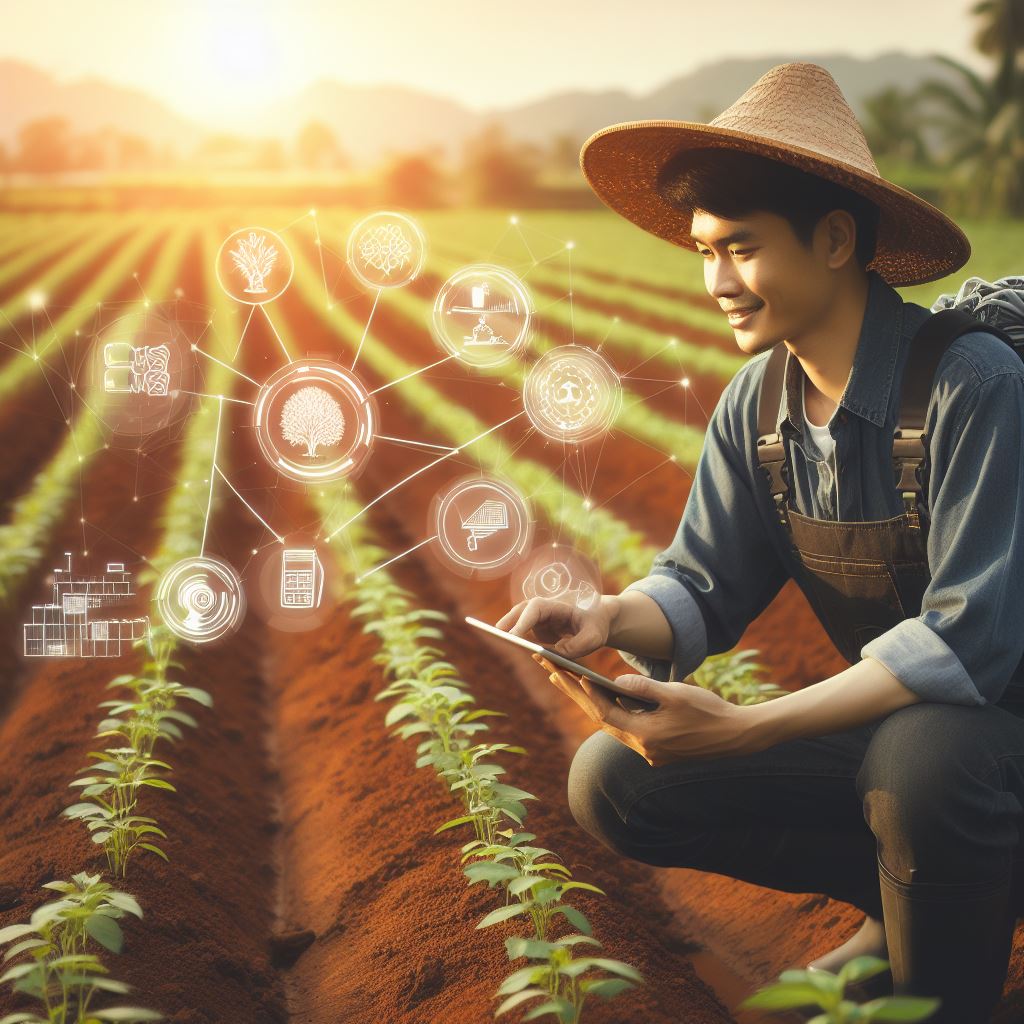Tech Advances in Crop Planting
Last Updated on February 17, 2024
Introduction
Crop planting plays a crucial role in agriculture as it ensures food security and sustains the world’s population. Rapid technological advancements have revolutionized various sectors, including crop planting.
Brief overview of the importance of crop planting in agriculture
Crop planting is essential for agriculture as it provides the necessary food, fiber, and fuel for human consumption and economic growth. It is the foundation of modern agricultural practices, enabling the production of diverse crops to meet the increasing demand.
The rapid technological advancements in various sectors, including crop planting
Technological advancements have greatly transformed crop planting methods and practices. Innovations like precision agriculture, automation, and genetic engineering have revolutionized the efficiency and productivity of crop production.
Farmers can now accurately monitor and manage their crops, ensuring optimal growth, minimal resource wastage, and increased yields.
Improved seed varieties, gene editing techniques, and biotechnology have led to crops with enhanced resistance to pests, diseases, and adverse environmental conditions.
Moreover, the development of sophisticated machinery, such as autonomous planters and drones, has revolutionized planting techniques by reducing human labor and increasing precision.
Advanced sensors, data analytics, and artificial intelligence help farmers make data-driven decisions regarding irrigation, fertilization, and pest control. This leads to reduced environmental impact and optimized resource utilization.
In essence, technology has played a pivotal role in advancing crop planting, making it more efficient, sustainable, and profitable for farmers. These advancements not only benefit the agricultural sector but also contribute to global food security and environmental stewardship.
Traditional Methods of Crop Planting
Crop planting has been an essential agricultural practice for centuries. Farmers have employed various conventional methods to ensure successful cultivation of crops year after year.
These traditional methods have their significance but also pose limitations and challenges. In this chapter, we will explore the conventional methods of crop planting, their explanation, limitations, and the challenges faced by farmers.
Broadcasting
- Seeds are scattered by hand over a wide area.
- Affordable and suitable for small-scale farming.
- Lack of control over seed placement leads to uneven crop growth.
- Difficult to manage weed control and pest management.
Manual Dibbling
- Farmers use a pointed stick to create individual holes for seed placement.
- More accurate than broadcasting, allowing better control and spacing of seeds.
- Time-consuming and labor-intensive, especially for larger farm areas.
- Not feasible for commercial farming due to high labor costs.
Transplanting
- Seedlings are grown separately and later transferred to the field.
- Provides better control over spacing and growth of crops.
- Requires nursery management, additional labor, and increased costs.
- Transplant shock can affect seedlings’ survival and overall crop yield.
Furrow Irrigation
- A system where water is applied to crops through furrows or channels.
- Allows efficient water distribution, especially in arid regions.
- Requires the creation of furrows, which can cause soil erosion.
- Water wastage due to evaporation and runoff is a common issue.
Traditional Plowing
- The process of tilling and turning over the soil with a plow.
- Helps break the soil, control pests, and mix organic matter.
- Soil erosion and loss of nutrients are common drawbacks.
- Machinery dependency and high fuel consumption contribute to pollution.
Manual Harrowing
- Breaking up soil clumps, leveling, and preparing seedbeds using hand tools.
- Facilitates better seed-to-soil contact and improves soil structure.
- Time-consuming and physically demanding, limiting large-scale implementation.
- Uneven soil texture and poor seed distribution may occur without proper skills.
Rotational Fallowing
- Temporarily leaving fields uncultivated to allow natural regeneration.
- Helps control pests, conserve soil moisture, and replenish nutrients.
- Reduced crop yield and economic losses during fallow periods.
- Risks of weed proliferation and weed seedbanks during the fallow period.
These traditional methods of crop planting have served farmers for generations, but they come with limitations and challenges. As agriculture continues to evolve, new technological advancements have emerged to address these issues and improve crop production efficiency.
The next section will delve into the exciting world of technology-driven innovations in crop planting. Stay tuned!
Essentially, traditional methods of crop planting have been employed for centuries but face limitations in terms of seed placement, labor requirements, water management, soil erosion, and crop yield.
As the agricultural industry progresses, it is crucial to explore new technologies to overcome these challenges and ensure sustainable and efficient crop production.
Recent Technological Advancements in Crop Planting
Precision agriculture has revolutionized the way we approach crop planting, with significant impacts on crop yields and overall productivity. This blog chapter will delve into the different technologies that have emerged in recent years, enhancing crop planting practices for farmers worldwide.
Explanation of various tech advances in crop planting
GPS-guided planting systems
One of the most transformative advancements in crop planting is the introduction of GPS-guided planting systems. These systems use satellite navigation to precisely locate planting points, ensuring accurate placement of seeds.
With GPS technology, farmers can maximize their yield potential by minimizing overlap and reducing input waste.
Automated planting machinery
Automated planting machinery has also played a crucial role in improving crop planting efficiency.
These machines can handle large volumes of seeds, significantly reducing the time and labor required for planting. With automated machinery, farmers can cover larger areas in less time, increasing overall productivity and profitability.
Variable rate technology for seed planting
Variable rate technology is another exciting development in crop planting. By utilizing data-driven insights, farmers can adjust seed planting rates based on soil conditions and other environmental factors.
This technology allows for targeted seed placement, optimizing germination rates and ensuring uniform plant density throughout the field.
Drones and aerial imaging for precise crop planting
Drones and aerial imaging have gained prominence in recent years, offering precise crop planting capabilities.
Equipped with sophisticated imaging sensors, drones can capture high-resolution images of the field, providing farmers with valuable information about crop health, soil moisture levels, and nutrient deficiencies.
This data allows farmers to make informed decisions when planting seeds, resulting in healthier crops and higher yields.
Sensor-based planting equipment for optimized seed placement
Sensor-based planting equipment has also emerged as a game-changer in crop planting. These advanced devices use sensors to detect soil conditions in real-time, ensuring optimal seed placement.
By accurately assessing factors such as soil moisture, temperature, and nutrient levels, farmers can adjust their planting technique to maximize seed germination and crop growth.
The integration of these technologies has not only improved the efficiency of crop planting but also reduced the environmental impact. Precision agriculture techniques have minimized the use of fertilizers, pesticides, and herbicides, as farmers can apply these inputs only where necessary.
This targeted approach reduces chemical runoff and minimizes the potential for soil and water pollution.
Additionally, these advancements have enabled farmers to make more precise decisions regarding irrigation. By monitoring soil moisture levels through sensors and aerial imaging, farmers can implement irrigation strategies tailored to the specific needs of different crop varieties and growth stages.
This efficient water management not only conserves resources but also avoids overwatering and related problems like soil erosion and nutrient leaching.
In fact, recent technological advancements in crop planting have transformed the agricultural landscape.
Precision agriculture, with its various components such as GPS-guided planting systems, automated machinery, variable rate technology, drones, aerial imaging, and sensor-based equipment, has revolutionized the way farmers approach crop planting.
These advancements have not only increased productivity and profitability but also reduced environmental impacts, making them invaluable tools for sustainable and efficient farming practices.
Read: Eco-Friendly Pest Management Strategies
Benefits of Tech Advances in Crop Planting
There are several benefits to incorporating technology advances in crop planting, including:
Increased Efficiency and Productivity in Planting Operations
One key benefit of incorporating technology advances in crop planting is the increased efficiency and productivity it brings to planting operations. By utilizing technology, farmers can streamline various aspects of planting, resulting in significant time and resource savings.
Modern machinery equipped with advanced planting systems, such as GPS-guided tractors and seeders, allow for precise and automated row spacing, eliminating the need for manual labor and reducing human error.
This automation leads to faster and more efficient planting processes, enabling farmers to cover larger areas in less time.
Additionally, the integration of technology enables farmers to optimize their planting schedules based on real-time data, such as weather conditions and soil moisture levels.
By taking advantage of this information, farmers can ensure they plant their crops at the most opportune times, enhancing overall efficiency and productivity.
Improved Precision Leading to More Uniform Crop Emergence and Growth
Another significant benefit of tech advances in crop planting is the improved precision it offers, resulting in more uniform crop emergence and growth.
Precision planting technology allows farmers to control seed placement with high accuracy, resulting in better germination rates and more consistent plant spacing.
Advanced seeders and planters utilize innovative features such as singulation mechanisms, seed spacing control, and seed depth adjustment capabilities.
These technologies enable farmers to plant seeds at optimal depths and spacing intervals, ensuring uniform crop emergence. As a result, plants have equal access to sunlight, water, and nutrients, leading to consistent growth and development.
Uniform crop emergence and growth not only improve yield potential but also facilitate easier crop management, including pest and disease control, as the plants are at similar growth stages.
Reduced Seed Waste and Optimized Resource Utilization
Tech advances in crop planting also contribute to reduced seed waste and optimized resource utilization. By incorporating technologies like variable rate seeders and precision placement systems, farmers can ensure optimal seed distribution, minimizing waste.
Variable rate seeders utilize data-driven algorithms to adjust the amount of seed deposited based on soil fertility maps or yield potential zones.
This enables farmers to allocate more seeds in areas with better nutrient availability and decrease seed density in less productive zones.
As a result, seed waste is significantly reduced, and resources are used more efficiently.
Furthermore, technology advancements enable farmers to identify and address planting issues promptly. Real-time data collection systems can monitor seed singulation rates, blockage, or seed metering inconsistencies.
This allows farmers to troubleshoot any equipment malfunctions or misaligned settings quickly, reducing seed waste.
Enhanced Data Collection Capabilities for Monitoring and Analysis
One of the key advantages of implementing tech advances in crop planting is the enhanced data collection capabilities it offers.
By utilizing technologies like sensors, drones, and satellite imagery, farmers can gather valuable information for monitoring and analysis purposes.
Sensors embedded in planters and machinery can monitor and collect data on planting conditions, including soil moisture levels, pH, temperature, and nutrient content.
This data enables farmers to assess and optimize planting practices, tailoring them to each field’s specific requirements.
Drones equipped with multispectral cameras and other advanced imaging technologies can capture aerial images of crop fields, providing valuable insights into plant health and growth.
This information can help identify areas of field stress, nutrient deficiencies, or potential pest infestations, enabling farmers to take timely corrective actions.
Satellite imagery can also be used to monitor crop growth and detect changes in vegetation indices. By analyzing these images, farmers can assess crop health, monitor growth patterns, and identify areas that require additional attention or intervention.
Potential for Increased Sustainability through Reduced Environmental Impact
Finally, tech advances in crop planting hold the potential for increased sustainability through reduced environmental impact. By incorporating precision technologies, farmers can minimize environmental harm while maintaining optimal crop production.
Precision planting systems, such as GPS-guided machinery, enable farmers to minimize overlap during planting, reducing fuel consumption and carbon emissions. Efficient planting practices also reduce soil erosion, preserving soil health and structure.
Moreover, precise seed placement, enabled by technology, allows for targeted pesticide, herbicide, and fertilizer application. This targeted approach minimizes chemical usage, optimizing resource efficiency while mitigating potential environmental damage.
Additionally, real-time data collected through technology systems can help farmers identify areas with excess water requirements, leading to more efficient irrigation management.
This not only conserves water resources but also prevents waterlogging and nutrient leaching.
Overall, the integration of tech advances in crop planting offers substantial benefits, including increased efficiency, improved precision, reduced waste, enhanced data collection, and the potential for increased sustainability.
Embracing technology in agriculture is key to meeting the growing demand for food while minimizing environmental impact.
Read: Sensor Tech in Crop Monitoring: A Guide

Challenges and Considerations
Cost implications and accessibility of advanced crop planting technologies
Advanced crop planting technologies often come with a high price tag, making them inaccessible for small-scale farmers. Investment in equipment may require financial resources beyond the means of many farmers.
Support from government or other institutions is necessary to ensure affordability and accessibility for all farmers.
Training and education required for farmers to adapt to new methods
Farmers need proper training and education to effectively utilize advanced crop planting technologies. This includes understanding the equipment, software, and data analysis required for successful implementation.
A comprehensive training program must be in place to facilitate the transition and ensure farmers are well-prepared.
Integration of different technologies and systems for seamless operations
Integration of various technologies and systems can optimize crop planting operations. However, achieving seamless integration can be challenging due to compatibility issues between different technologies.
Efforts should be made to develop standardized interfaces and protocols to ensure smooth coordination.
Potential drawbacks, such as reliance on technology and cybersecurity risks
Excessive reliance on technology can make farmers vulnerable to system failures and cyberattacks. An over-reliance on technology may also lead to a loss of traditional farming knowledge and skills.
Cybersecurity measures must be reinforced to protect critical agricultural data and prevent potential breaches.
In fact, while there are numerous advantages to advanced crop planting technologies, there are significant challenges and considerations to address. The cost implications and accessibility of these technologies must be carefully evaluated to ensure fair opportunities for all farmers.
Training and education programs should be implemented to equip farmers with the necessary skills to adapt to new methods.
Efforts should also focus on integrating different technologies seamlessly and addressing potential drawbacks such as reliance on technology and cybersecurity risks.
By carefully navigating these challenges, the agricultural industry can harness the full potential of tech advances in crop planting.
Read: Green Tech: Sustainable Crop Cultivation
Future Trends and Conclusions
As we conclude our discussion on the ongoing developments in crop planting technology, it is evident that the future holds exciting possibilities. Emerging trends such as robotic planting systems and AI integration are set to revolutionize the industry.
Robotic Planting Systems
Robots are increasingly being used in crop planting, offering precision and efficiency beyond human capabilities. These autonomous machines can plant seeds with accuracy and consistency, optimizing crop growth.
AI Integration
Artificial intelligence is being integrated into crop planting systems, enabling real-time data analysis and decision-making. AI algorithms can analyze soil conditions, weather patterns, and plant health, allowing farmers to make informed decisions for better crop yield.
Improved Efficiency
Tech advances in crop planting are streamlining processes and improving efficiency. Farmers can now cover larger areas in less time with automated planting machines, reducing labor costs and increasing productivity.
Increased Precision
With the use of advanced technology, farmers can achieve improved precision in seed placement, fertilizer application, and irrigation. This precision reduces resource wastage and ensures optimal utilization for sustainable farming practices.
Enhancing Sustainability
Tech advances in crop planting are contributing to sustainable agriculture. Through precise planting techniques, farmers can reduce chemical usage and minimize environmental impact while maintaining or even increasing crop yields.
Improved Crop Health Monitoring
Sensors and remote monitoring systems are enabling farmers to track plant health and respond quickly to diseases or nutrient deficiencies. Early detection and timely intervention can save crops from damage and maximize their potential.
Integration of Big Data
The collection and analysis of vast amounts of data is becoming progressively important in agricultural decision-making. Big data analytics can provide insights into optimal planting times, crop rotation strategies, and yield forecasting, leading to more profitable farming practices.
Resource Conservation
Tech advances in crop planting help in conserving resources like water and energy. Smart irrigation systems and sensors monitor soil moisture levels, ensuring water is used efficiently, and minimizing wastage.
Precision Weed Management
Weed control is a significant challenge in agriculture, impacting crop growth and yield. Advanced technologies like robotic weeders and AI-powered weed detection systems can precisely target and eliminate weeds, reducing the need for herbicides.
In general, the potential future impact and importance of tech advances in crop planting cannot be overstated. These advancements offer immense benefits such as increased efficiency, enhanced precision, improved sustainability, and resource conservation.
By embracing emerging trends like robotic planting systems, AI integration, and the use of big data, farmers can optimize their operations and achieve higher productivity.
Additionally, these technologies enable farmers to respond promptly to changing environmental conditions, ensuring the health and success of their crops.
As we move forward, continuous research and development in crop planting technology will pave the way for further innovations.
It is an exciting time for the agriculture industry, and the integration of technology will play a vital role in securing food production for a growing global population.
Read: Data-Driven Farming: Tech for Crop Analysis
Conclusion
In this blog post, we explored the various tech advances in crop planting and their significance in the agricultural industry.
We discussed the key points, such as precision planting, automated systems, and data-driven decision making.
It is evident that adopting these tech advances can lead to increased efficiency, improved yields, and reduced costs.
Therefore, it is crucial for farmers to explore and embrace these new technologies to stay competitive in the agricultural industry.
By doing so, they can optimize their planting processes, minimize waste, and maximize their profits.
Furthermore, incorporating tech advances can also help address some of the challenges faced by the industry, such as labor shortages and climate change.
It is important for farmers to keep up with the latest advancements and continuously educate themselves about the potential benefits.
Overall, the future of crop planting lies in the integration of technology, and it is essential for farmers to adapt and embrace these innovations.
By doing so, they can ensure long-term sustainability and success in the ever-evolving agricultural landscape.


